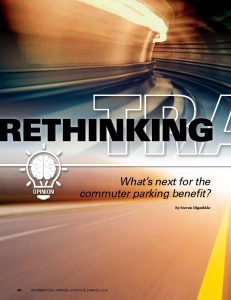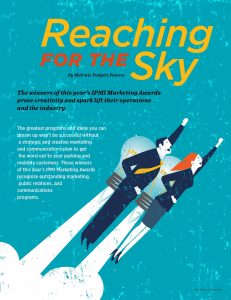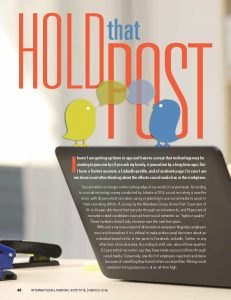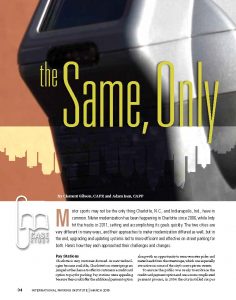 by Steven Higashide
by Steven Higashide
What’s next for the commuter parking benefit?
LATE LAST YEAR, Congress finally permanently addressed a longstanding imbalance in the federal tax code that allowed commuters to exclude up to $250 per month from their income toward the cost of parking associated with their trip to work, but only $130 per month for mass transit. From now on, parking and transit receive equal treatment with an exclusion of up to $255 per month (indexed to cost-of-living inflation) for both. While this brings a bit of essential fairness to the system, it should be just the first step toward rethinking our wasteful commuter benefits policy, which dates back to the 1980s.
In our 2014 report “Subsidizing Congestion,” TransitCenter and the Frontier Group found the federal commuter parking subsidy:
- Costs American taxpayers billions of dollars per year.
- Puts hundreds of thousands of additional cars on the road, primarily in our most congested urban neighborhoods.
- Disproportionately benefits high-income workers, even though it was intended as middle-class tax relief.
We estimate that roughly 42 million Americans (less than one-third of the workforce) take advantage of the parking subsidy, resulting in more than $7 billion in foregone tax revenue every year. That’s a huge sum at a time when the federal government has struggled to fund transportation projects. It’s equivalent to 13 percent of all spending from the Highway Trust Fund, which historically relies on user fees such as the gas tax but is today propped up through transfers from the Federal Reserve’s surplus fund.
This $7.3 billion in foregone tax revenue has a huge opportunity cost. The same amount of money could pay for several new light rail and rapid-bus projects every year, giving workers (and everyone else) more ways to get around. It could go to road safety (the U.S. spent $828 million on the National Highway Traffic Safety Administration in 2014), rail (Amtrak’s budget was $1.4 billion in 2014), or any number of worthy transportation efforts.
More Traffic
Parking professionals know that price sends a strong signal to drivers and has a significant effect on consumer behavior. Intuitively, a discount on the price of parking will increase people’s willingness to drive to work, which is exactly the outcome policymakers should avoid. Instead, as our analysis shows, by subsidizing parking, taxpayers are essentially buying themselves more traffic in urban downtowns—the same places where smart city leaders are trying to reduce congestion.
That’s because as far as the parking subsidy is concerned, the relevant dollar amount is a parking space’s fair-market value, defined by the IRS as “the amount an employee would have to pay a third party in an arm’slength transaction to buy or lease the benefit.”
By this logic, parking in most of the country has no market value; in most suburban, exurban, and rural communities, parking is ubiquitous and free. On the other hand, parking in urban downtown neighborhoods has a high market value, as shown by the fees charged by commercial lots in cities such as Washington, D.C. ($270 per month) and Philadelphia ($313 per month), according to Colliers International’s 2012 Parking Rate Survey.
We simulated the effects of the parking subsidy with and without parity with the transit commuter benefit on several suburban-urban commutes (see graphic). The results suggest a small but meaningful effect on the kind of transportation commuters choose to take. Between Edison, N.J., and New York City, for example, we estimate that the parking subsidy increases vehicle commutes by 0.9 percent.
By contrast, the transit subsidy discourages driving to work. Before the recent change that made the two subsidies equal, we estimated that the transit provision reduced vehicle commutes in the Edison-New York market by 0.5 percent. The higher transit benefit should reduce vehicle commutes in that market by 0.9 percent; in other words, it will cancel out the parking benefit’s impact on vehicle commutes. Just because this is the case in Edison, however, does not mean it will be for the rest of the country. In markets where transit is less accessible than in the dense suburbs of northern New Jersey, the increase in the transit benefit won’t completely counteract the impact of the parking benefit.
Looking at the country as a whole, we estimate that the parking subsidy adds about 820,000 drivers to the road while pulling 32,000 would-be riders away from transit. If these additional car commuters drive the distance a typical American does, they are responsible for an increase in driving of about 4.6 billion miles per year. While this figure is just 0.15 percent of annual American vehicle miles traveled, it has a disproportionate effect on congestion because it’s concentrated in urban areas. In other words, while the $7 billion in tax revenue foregone due to the parking benefit could be well-spent on transportation projects, simply abolishing the benefit and giving the money back to taxpayers would also improve traffic.
Uneven Effects
Commuter benefits were partially justified as a benefit for the working class, but the parking and transit subsidies actually provide larger benefits for high-income workers. With parking, a household making $300,000 a year reaps a benefit more than three times larger than a household making $17,500 due to the fact that the wealthier household pays a higher marginal rate in income tax. The most expensive transit trips tend to be on commuter trains and buses that cater to suburban residents, who are thus likelier to use the full value of the transit benefit. Workers who travel to Grand Central Station from the wealthy New York suburb of Bronxville, for example, can now pay the entire cost of their monthly Metro North pass with pre-tax dollars. Workers who live in New York City can do the same, but a monthly New York City Transit pass is only $116.50, meaning nearly $140 of the benefit is useless to them.
This disparate impact occurs with many tax exclusions, of course, but it’s particularly strange for commuting subsidies given that Congress originally justified the provision as a middle-class tax benefit. We reviewed the Congressional Record dating back to the 1970s, when the IRS was considering treating parking as a taxable fringe benefit—part of a broader reaction to companies that were offering more fringe benefits to workers as a way to reduce their tax burden. Congress responded with dismay, passing several measures to delay enforcement of the IRS regulations. As Rep. Barber Conable of New York said in 1978, “This practice on the part of the IRS is potentially a way of raising substantial additional taxes, not at the expense of the wealthy, but at the expense of the working-class American.” Notably absent from the Record was any mention of the parking provision’s impact on actual transportation policy.
Lawmakers evidently did not anticipate or care about the subsidy’s potential to increase traffic. In 1984, the parking exemption was officially codified. Soon after, the IRS ruled that employers could also exclude a much smaller amount—$15 per month—for public transportation. (A New York subway token was 90 cents so transit commuters there paid about $19 per month.) Legislators beefed up the transit benefit in the 1990s, this time with a transportation policy justification of encouraging public transit and reducing automobile traffic. But the transit benefit remained less than half the size of the parking benefit until 2009, when the federal stimulus bill temporarily set the benefits equal to each other. This provision expired and was renewed several times. And then, late in 2015, Congress finally acted to create permanent parity between the benefits.
Data and Reform
Rather than see this recent change as the final chapter in the story of commuter benefits, we think it must be the beginning of a more comprehensive effort to reform transportation and tax policy. Simply put, employer-provided parking should be taxed as a fringe benefit. Employers who provide free parking or subsidize parking in congested urban areas are in fact providing a valuable benefit to their workers. Furthermore, unlike the transit benefit, there is no plausible policy justification for providing a benefit specifically for parking.
Other countries have found relatively straightforward ways to tax employer-provided parking. In Austria, employees who receive free parking from their employers have roughly $20 per month added to their wages for tax purposes. This requirement applies only in zones where on-street parking is restricted. (Though given the much higher cost of parking and owning a car in Austria, it seems the Austrian tax code also severely underestimates the value of free parking to employees.) Australia also taxes employee parking as a fringe benefit; the tax is levied on the employer (not the worker), and the value is determined by the lowest fee available for commercial parking within 0.6 miles of the workplace.
Newer, better data are also needed. Compared to spending programs, federal tax exemptions are rarely evaluated by the government, so there is little data about their impact on federal budgets and consumer behavior. What evaluation does exist tends to focus on the cost of the exemptions rather than their effect on society. This is certainly true of the parking benefit. In the course of conducting our research, we also confronted a lack of data about parking more broadly. This gap needs to be addressed by federal agencies such as the U.S. Department of Transportation, Environmental Protection Agency, and Government Accountability Office.
For future evaluations, the federal government might consider following the example of local governments, which often use parking pricing and policy as a way to achieve policy goals that include promoting environmental sustainability or reducing congestion in important commercial areas. For example, Cambridge, Mass., requires developers of commercial projects with five or more parking spaces to provide at least three transportation demand management strategies (such as bicycle parking, incentives for transit use, and market-rate automobile parking). Many other municipalities—such as Arlington, Va.; Boulder, Colo.; and Seattle, Wash.—have similar provisions aimed at discouraging automobile commuting and encouraging
the use of other kinds of transportation.
The current federal parking subsidy counteracts these ongoing local efforts and distorts the commuting choices that workers across the country make every day. While a few commercial lot operators may benefit from the additional traffic, the parking subsidy arguably hurts others by worsening traffic, which dissuades people from coming downtown for shopping and entertainment. Transit parity is a clear sign of progress, but with billions of dollars at stake, it’s ultimately just a first step toward a more equitable and thoughtful transportation policy.
STEVEN HIGASHIDE is senior program analyst for TransitCenter. He can be reached
at shigashide@transitcenter.org.
TPP-2016-03 Rethinking Transit
 The Street Reach Indy campaign features repurposed parking meters to curb panhandling and help homeless people in Indianapolis, Ind. The program is a partnership between the Coalition for Homelessness Intervention and Prevention (CHIP) and Downtown Indy, Inc., and replaces CHIP’s Know Outlets program.
The Street Reach Indy campaign features repurposed parking meters to curb panhandling and help homeless people in Indianapolis, Ind. The program is a partnership between the Coalition for Homelessness Intervention and Prevention (CHIP) and Downtown Indy, Inc., and replaces CHIP’s Know Outlets program.
 by John V. Collins, CAPP
by John V. Collins, CAPP
